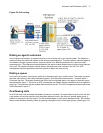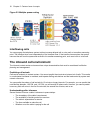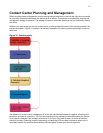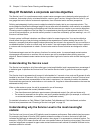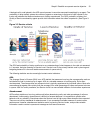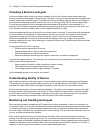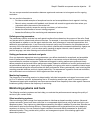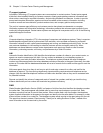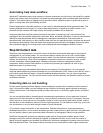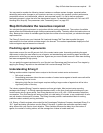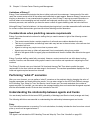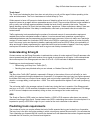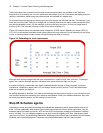Step #1 Establish a corporate service objective 25
You can use pre-recorded conversations between agents and customers to train agents and for ongoing
evaluation.
You can use the information to
• Provide recorded examples of exceptional service and unacceptable service to agents in training.
• Record, review, annotate with feedback, and forward call records to agents who then review your
comments within the context of the actual call.
• Calibrate and routinely access the scoring consistency of call monitors.
• Assess the effectiveness of current training programs.
• Assess the efficiency of the monitoring and assessment process.
Defining scoring parameters
The parameters used to evaluate how well agents handle calls are based on the purpose of the calls. Goals
vary across calls for inbound and outbound services. For example, in an outbound sales environment quality
may be based on whether or not the agent made the sale, took advantage of cross-sell opportunities, and
adhered to a pre-defined script. In an inbound environment quality may be based on the completeness and
accuracy of the information and whether or not the caller’s questions were answered satisfactorily. Agents are
also evaluated on “soft skills”, such as voice quality, pausing at regular intervals, rate of speech, use of
positive language, and other listening and communication skills.
Setting performance standards and goals
Once you determine appropriate scoring parameters, you define standards for exceptional and acceptable
levels of performance. Assessment standards are based on consensus and must be clearly defined and
communicated to monitors and agents. Collaborate with agents in setting performance goals and clearly
define exceptional service and interim performance steps. Determine a baseline of current performance and
set performance steps for an agent group. Provide agents in the group who meet or exceed the interim target
with rewards and recognition commensurate with their performance. When systematically used in training and
coaching recorded sessions positively impact productivity. Fair assessment is good for moral and motivation,
and contributes to an environment in which agents can learn and grow.
Monitoring frequency
The frequency of monitoring sessions is determined by individual companies and ranges from once a month
to 15 or 20 sessions a month. Implementing five to 10 monitoring sessions per month is common practice.
Trainees and agents with consistently low scores are monitored more frequently than other agents. Resource
limitations typically influence the frequency of monitoring.
Monitoring systems and tools
The following monitoring systems and tools help you evaluate the performance and manage the quality of
service of your contact center.
Silent monitoring systems
Silent monitoring systems range from tape recorders to client/server based recording systems. Advanced
systems schedule, record, and store voice files in a compressed digital format using a real-time link to your
telephone system. They capture any data tables accessed by the agent in addition to voice data. Silences are
eliminated to optimize monitoring efficiency. Recording sessions can be played back from any telephone,
anywhere, at anytime. You can customize agent evaluation forms and define parameters for quality with
advanced systems. They provide activity, status, and management reports for evaluating agents and
observation practices.



